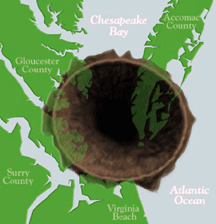
|
Volume XVII, Issue 4 - January 22 - January 28, 2009
|
|
Columns Reviews |
Bay Reflections
Filling the Crater in Our Hearts
We’ve inherited the capacity to transform our weaknesses into strengths
by Elizabeth Ayres
Often, in the journal that is my heart, the only entry is a note about how the sun looked on the Chesapeake Bay that day. If it sparkled. If it spread across the surface like a sheet of silver silk. If it disappeared altogether into heavy leaden swells.
Other days are more eventful. Everything that’s ever happened to me is there, in the journal that is my heart, even the things I would like to erase because they cause more hurt than I want to endure, or because they fill me with a sharp and bitter anger, or because they prove I am not nearly as good a person as I’d like to believe myself to be.
Last year I discovered something that warranted a long entry in my journal. The Chesapeake Bay has a hole in it. Some 35 million years ago, a giant meteorite crashed to earth, gouging a deep crater in the ocean floor. Millions of tons of water, sediment and shattered rock spewed into the air for hundreds of miles along the east coast, and the resulting tsunami may have topped the Blue Ridge Mountains.
The hole has filled in over the eons, of course. Until 1983, no one even suspected its existence, because the crater — twice the size of Rhode Island and nearly as deep as the Grand Canyon — is buried 300 to 500 meters beneath the lower Bay and its surrounding peninsulas. Acknowledged or not, the chasm makes its presence felt. Continual slumping of rubble within it affects the course of rivers. Groundwater is easily contaminated by subsurface salt. All four major earthquakes in the region were near or inside the trace of the crater rim.
Last year, I made another long entry in the journal that is my heart. An African American was elected president of the United States. He was inaugurated this week, the day after we celebrated the birthday of another African American whose dream has been inscribed in the journal that is the American heart.
I’ve been re-reading Martin Luther King’s touchstone speech. I’ve also been re-reading James Baldwin’s Notes of a Native Son. And I’ve been thinking about that hole underneath the Chesapeake Bay. After the meteor struck, the sea floor around the crater became a dead zone for some 3,000 years. King and Baldwin both describe the dead zone created by slavery: segregation, discrimination, oppression, injustice. The burden of shame shouldered by generation after generation of white Americans. The loneliness endured by generation after generation of black Americans, exiles in their own land. Everyone scrabbling for so long in the hard soil of mutual fear.
These things are penned in the journals of all our hearts. We cannot erase them, but we can turn the page now and start something new. I have on my desk an announcement from the Calvert Gazette, dated June 21, 1919. It says that “the colored voters of Calvert County” have taken stock of “the very valuable part they had taken in the war” and think themselves “entitled to some political recognition.” Consequently, “they decided to endeavor to put a colored man on the ticket this fall.”
Political recognition of value and entitlement. An affirmation of equality. Tuesday’s inauguration was that, and more. It was, if you will, proof that life has been fully restored after a devastating impact.
America will always be affected by her slave-owning past, just as she will always be shaped by the destruction of her indigenous culture. Forever we will be subject to slumpings of a particular kind of rubble, to unique subsurface tensions, to fault lines that invite inexorable seismic disturbances; these are our collective heritage. But something else is ours as well. Something we’ve inherited as a people. It is the capacity to transform our weaknesses into strengths.
Martin Luther King prophesied that one day we would “hew out of the mountain of despair a stone of hope.” Barack Obama insisted, “Yes, we can.” Whatever shape the stone of hope takes, I am glad I’m one of 300 million Americans carving it.